http://commons.wikimedia.org/wiki/%C3%89douard_Manet
http://www.wikipaintings.org/en/edouard-manet
Édouard Manet (US pron.: /mæˈneɪ/ or UK /ˈmæneɪ/; French: [edwaʁ manɛ]; 23 January 1832 – 30 April 1883) was a French painter. One of the first 19th-century artists to approach modern and postmodern-life subjects, he was a pivotal figure in the transition from Realism to Impressionism.
His early masterworks, The Luncheon on the Grass (Le déjeuner sur l&herbe) and Olympia, engendered great controversy and served as rallying points for the young painters who would create Impressionism. Today, these are considered watershed paintings that mark the genesis of modern art.
Biography
Born into an upper class household with strong political connections, Manet rejected the future originally envisioned for him, and became engrossed in the world of painting. He married Suzanne Leenhoff in 1863. The last 20 years of Manet&s life saw him form bonds with other great artists of the time, and develop his own style that would be heralded as innovative and serve as a major influence for future painters.
Early life
Édouard Manet was born in Paris on 23 January 1832, to an affluent and well-connected family. His mother, Eugénie-Desirée Fournier, was the daughter of a diplomat and goddaughter of the Swedish crown prince Charles Bernadotte, from whom the Swedish monarchs are descended. His father, Auguste Manet, was a French judge who expected Édouard to pursue a career in law. His uncle, Edmond Fournier, encouraged him to pursue painting and took young Manet to the Louvre. In 1841 he enrolled at secondary school, the Collège Rollin. In 1845, at the advice of his uncle, Manet enrolled in a special course of drawing where he met Antonin Proust, future Minister of Fine Arts and subsequent lifelong friend.
At his father&s suggestion, in 1848 he sailed on a training vessel to Rio de Janeiro. After he twice failed the examination to join the Navy, his father relented to his wishes to pursue an art education. From 1850 to 1856, Manet studied under the academic painter Thomas Couture. In his spare time, Manet copied the old masters in the Louvre.
From 1853 to 1856 he visited Germany, Italy, and the Netherlands, during which time he was influenced by the Dutch painter Frans Hals, and the Spanish artists Diego Velázquez and Francisco José de Goya.
In 1856, Manet opened a studio. His style in this period was characterized by loose brush strokes, simplification of details and the suppression of transitional tones. Adopting the current style of realism initiated by Gustave Courbet, he painted The Absinthe Drinker (1858–59) and other contemporary subjects such as beggars, singers, Gypsies, people in cafés, and bullfights. After his early career, he rarely painted religious, mythological, or historical subjects; examples include his Christ Mocked, now in the Art Institute of Chicago, and Christ with Angels, in the Metropolitan Museum of Art, New York. Manet had two canvases accepted at the Salon in 1861. A portrait of his mother and father, who at the time was paralysed and robbed of speech by a stroke, was ill received by critics. The other, The Spanish Singer, was admired by Theophile Gautier, and placed in a more conspicuous location as a result of its popularity with Salon-goers. Manet&s work, which appeared "slightly slapdash" when compared with the meticulous style of so many other Salon paintings, intrigued some young artists. The Spanish Singer, painted in a "strange new fashion [-] caused many painters& eyes to open and their jaws to drop."
Music in the Tuileries
Music in the Tuileries is an early example of Manet&s painterly style. Inspired by Hals and Velázquez, it is a harbinger of his lifelong interest in the subject of leisure.
While the picture was regarded as unfinished by some, the suggested atmosphere imparts a sense of what the Tuileries gardens were like at the time; one may imagine the music and conversation.
Here, Manet has depicted his friends, artists, authors, and musicians who take part, and he has included a self-portrait among the subjects.
Luncheon on the Grass (Le déjeuner sur l&herbe)
A major early work is The Luncheon on the Grass (Le déjeuner sur l&herbe). The Paris Salon rejected it for exhibition in 1863 but Manet exhibited it at the Salon des Refusés (Salon of the Rejected) later in the year. Emperor Napoleon III had initiated The Salon des Refusés after the Paris Salon rejected more than 4,000 paintings in 1863. Manet employed model Victorine Meurent, his wife Suzanne, future brother-in-law Ferdinand Leenhoff, and one of his brothers to pose. Meurent also posed for several more of Manet&s important paintings including Olympia; and by the mid 1870s she became an accomplished painter in her own right.
The painting&s juxtaposition of fully dressed men and a nude woman was controversial, as was its abbreviated, sketch-like handling, an innovation that distinguished Manet from Courbet. At the same time, Manet&s composition reveals his study of the old masters, as the disposition of the main figures is derived from Marcantonio Raimondi&s engraving of the Judgement of Paris (c. 1515) based on a drawing by Raphael.
Two additional works cited by scholars as important precedents for Le déjeuner sur l&herbe are Pastoral Concert (c. 1510, The Louvre) and The Tempest (Gallerie dell&Accademia, Venice), both of which are attributed variously to Italian Renaissance masters Giorgione or Titian. The Tempest is an enigmatic painting featuring a fully dressed man and a nude woman in a rural setting. The man is standing to the left and gazing to the side, apparently at the woman, who is seated and breastfeeding a baby; the relationship between the two figures is unclear. In Pastoral Concert, two clothed men and a nude woman are seated on the grass, engaged in music making, while a second nude woman stands beside them.
Olympia
As he had in Luncheon on the Grass, Manet again paraphrased a respected work by a Renaissance artist in the painting Olympia (1863), a nude portrayed in a style reminiscent of early studio photographs, but whose pose was based on Titian&s Venus of Urbino (1538). The painting is also reminiscent of Francisco Goya&s painting The Nude Maja (1800).
Manet embarked on the canvas after being challenged to give the Salon a nude painting to display. His uniquely frank depiction of a self-assured prostitute was accepted by the Paris Salon in 1865, where it created a scandal. According to Antonin Proust, "only the precautions taken by the administration prevented the painting being punctured and torn" by offended viewers. The painting was controversial partly because the nude is wearing some small items of clothing such as an orchid in her hair, a bracelet, a ribbon around her neck, and mule slippers, all of which accentuated her nakedness, sexuality, and comfortable courtesan lifestyle. The orchid, upswept hair, black cat, and bouquet of flowers were all recognized symbols of sexuality at the time. This modern Venus& body is thin, counter to prevailing standards; the painting&s lack of idealism rankled viewers. The painting&s flatness, inspired by Japanese wood block art, serves to make the nude more human and less voluptuous. A fully dressed black servant is featured, exploiting the then-current theory that black people were hyper-sexed. That she is wearing the clothing of a servant to a courtesan here furthers the sexual tension of the piece.
Olympia&s body as well as her gaze is unabashedly confrontational. She defiantly looks out as her servant offers flowers from one of her male suitors. Although her hand rests on her leg, hiding her pubic area, the reference to traditional female virtue is ironic; a notion of modesty is notoriously absent in this work. A contemporary critic denounced Olympia&s "shamelessly flexed" left hand, which seemed to him a mockery of the relaxed, shielding hand of Titian&s Venus. Likewise, the alert black cat at the foot of the bed strikes a sexually rebellious note in contrast to that of the sleeping dog in Titian&s portrayal of the goddess in his Venus of Urbino.
"Olympia" was the subject of caricatures in the popular press, but was championed by the French avant-garde community, and the painting&s significance was appreciated by artists such as Gustave Courbet, Paul Cézanne, Claude Monet, and later Paul Gauguin.
As with Luncheon on the Grass, the painting raised the issue of prostitution within contemporary France and the roles of women within society.
Life and times
The roughly painted style and photographic lighting in these works was seen as specifically modern, and as a challenge to the Renaissance works Manet copied or used as source material. His work is considered &early modern&, partially because of the black outlining of figures, which draws attention to the surface of the picture plane and the material quality of paint.
He became friends with the Impressionists Edgar Degas, Claude Monet, Pierre-Auguste Renoir, Alfred Sisley, Paul Cézanne and Camille Pissarro through another painter, Berthe Morisot, who was a member of the group and drew him into their activities. The grand niece of the painter Jean-Honoré Fragonard, Morisot had her first painting accepted in the Salon de Paris in 1864, and she continued to show in the salon for the next ten years.
Manet became the friend and colleague of Berthe Morisot in 1868. She is credited with convincing Manet to attempt plein air painting, which she had been practicing since she was introduced to it by another friend of hers, Camille Corot. They had a reciprocating relationship and Manet incorporated some of her techniques into his paintings. In 1874, she became his sister-in-law when she married his brother, Eugene.
Unlike the core Impressionist group, Manet maintained that modern artists should seek to exhibit at the Paris Salon rather than abandon it in favor of independent exhibitions. Nevertheless, when Manet was excluded from the International Exhibition of 1867, he set up his own exhibition. His mother worried that he would waste all his inheritance on this project, which was enormously expensive. While the exhibition earned poor reviews from the major critics, it also provided his first contacts with several future Impressionist painters, including Degas.
Although his own work influenced and anticipated the Impressionist style, he resisted involvement in Impressionist exhibitions, partly because he did not wish to be seen as the representative of a group identity, and partly because he preferred to exhibit at the Salon. Eva Gonzalès was his only formal student.
He was influenced by the Impressionists, especially Monet and Morisot. Their influence is seen in Manet&s use of lighter colors, but he retained his distinctive use of black, uncharacteristic of Impressionist painting. He painted many outdoor (plein air) pieces, but always returned to what he considered the serious work of the studio.
Manet enjoyed a close friendship with composer Emmanuel Chabrier, painting two portraits of him; the musician owned 14 of Manet&s paintings and dedicated his Impromptu to Manet&s wife.
Throughout his life, although resisted by art critics, Manet could number as his champions Émile Zola, who supported him publicly in the press, Stéphane Mallarmé, and Charles Baudelaire, who challenged him to depict life as it was. Manet, in turn, drew or painted each of them.
Cafe scenes
The Cafe Concert, 1878. Scene set in the Cabaret de Reichshoffen on the Boulevard Rochechouart, where women on the fringes of society freely intermingled with well-heeled gentlemen. The Walters Art Museum.
Manet&s paintings of cafe scenes are observations of social life in 19th-century Paris. People are depicted drinking beer, listening to music, flirting, reading, or waiting. Many of these paintings were based on sketches executed on the spot. He often visited the Brasserie Reichshoffen on boulevard de Rochechourt, upon which he based At the Cafe in 1878. Several people are at the bar, and one woman confronts the viewer while others wait to be served. Such depictions represent the painted journal of a flâneur. These are painted in a style which is loose, referencing Hals and Velázquez, yet they capture the mood and feeling of Parisian night life. They are painted snapshots of bohemianism, urban working people, as well as some of the bourgeoisie.
In Corner of a Cafe Concert, a man smokes while behind him a waitress serves drinks. In The Beer Drinkers a woman enjoys her beer in the company of a friend. In The Cafe Concert, shown at right, a sophisticated gentleman sits at a bar while a waitress stands resolutely in the background, sipping her drink. In The Waitress, a serving woman pauses for a moment behind a seated customer smoking a pipe, while a ballet dancer, with arms extended as she is about to turn, is on stage in the background.
Manet also sat at the restaurant on the Avenue de Clichy called Pere Lathuille&s, which had a garden in addition to the dining area. One of the paintings he produced here was Chez le père Lathuille (At Pere Lathuille&s), in which a man displays an unrequited interest in a woman dining near him.
In Le Bon Bock (1873), a large, cheerful, bearded man sits with a pipe in one hand and a glass of beer in the other, looking straight at the viewer.
Paintings of social activities
Manet painted the upper class enjoying more formal social activities. In Masked Ball at the Opera, Manet shows a lively crowd of people enjoying a party. Men stand with top hats and long black suits while talking to women with masks and costumes. He included portraits of his friends in this picture.
His 1868 painting The Luncheon was posed in the dining room of the Manet house.
Manet depicted other popular activities in his work. In The Races at Longchamp, an unusual perspective is employed to underscore the furious energy of racehorses as they rush toward the viewer. In Skating, Manet shows a well dressed woman in the foreground, while others skate behind her. Always there is the sense of active urban life continuing behind the subject, extending outside the frame of the canvas.
In View of the International Exhibition, soldiers relax, seated and standing, prosperous couples are talking. There is a gardener, a boy with a dog, a woman on horseback—in short, a sample of the classes and ages of the people of Paris.
War
The Execution of Emperor Maximilian, 1867. Museum of Fine Arts, Boston. The least finished of three large canvases devoted to the execution of Maximilian I of Mexico.
Manet&s response to modern life included works devoted to war, in subjects that may be seen as updated interpretations of the genre of "history painting". The first such work was the Battle of the Kearsarge and Alabama (1864), a sea skirmish known as the Battle of Cherbourg (1864) from the American Civil War which took place off the French coast, and may have been witnessed by the artist.
Of interest next was the French intervention in Mexico; from 1867 to 1869 Manet painted three versions of the Execution of Emperor Maximilian, an event which raised concerns regarding French foreign and domestic policy. The several versions of the Execution are among Manet&s largest paintings, which suggests that the theme was one which the painter regarded as most important. Its subject is the execution by Mexican firing squad of a Habsburg emperor who had been installed by Napoleon III. Neither the paintings nor a lithograph of the subject were permitted to be shown in France. As an indictment of formalized slaughter the paintings look back to Goya, and anticipate Picasso&s Guernica.
In January 1871, Manet traveled to Oloron-Sainte-Marie in the Pyrenees. In his absence his friends added his name to the "Fédération des artistes" (see: Courbet) of the Paris Commune. Manet stayed away from Paris, perhaps, until after the semaine sanglante: in a letter to Berthe Morisot at Cherbourg (10 June 1871) he writes, "We came back to Paris a few days ago..." (the semaine sanglante ended on 28 May).
The Prints and Drawings Collection of the Museum of Fine Arts (Budapest) has a watercolour/gouache (The Barricade) by Manet, depicting a summary execution of Communards by Versailles troops based on a lithograph of the execution of Maximilian. A similar piece (The Barricade), oil on plywood, is held by a private collector.
On 18 March 1871, he wrote to his (confederate) friend Félix Bracquemond in Paris about his visit to Bordeaux, the provisory seat of the French National Assembly of the Third French Republic where Emile Zola introduced him to the sites: "I never imagined that France could be represented by such doddering old fools, not excepting that little twit Thiers..." If this could be interpreted as support of the Commune, a following letter to Bracquemond (21 March 1871) expressed his idea more clearly: "Only party hacks and the ambitious, the Henrys of this world following on the heels of the Milliéres, the grotesque imitators of the Commune of 1793..." He knew the communard Lucien Henry to have been a former painter&s model and Millière, an insurance agent. "What an encouragement all these bloodthirsty caperings are for the arts! But there is at least one consolation in our misfortunes: that we&re not politicians and have no desire to be elected as deputies".
Paris
Manet depicted many scenes of the streets of Paris in his works. The Rue Mosnier Decked with Flags depicts red, white, and blue pennants covering buildings on either side of the street; another painting of the same title features a one-legged man walking with crutches. Again depicting the same street, but this time in a different context, is Rue Mosnier with Pavers, in which men repair the roadway while people and horses move past.
The Railway, widely known as The Gare Saint-Lazare, was painted in 1873. The setting is the urban landscape of Paris in the late 19th century. Using his favorite model in his last painting of her, a fellow painter, Victorine Meurent, also the model for Olympia and the Luncheon on the Grass, sits before an iron fence holding a sleeping puppy and an open book in her lap. Next to her is a little girl with her back to the painter, watching a train pass beneath them.
Instead of choosing the traditional natural view as background for an outdoor scene, Manet opts for the iron grating which "boldly stretches across the canvas" The only evidence of the train is its white cloud of steam. In the distance, modern apartment buildings are seen. This arrangement compresses the foreground into a narrow focus. The traditional convention of deep space is ignored.
Historian Isabelle Dervaux has described the reception this painting received when it was first exhibited at the official Paris Salon of 1874: "Visitors and critics found its subject baffling, its composition incoherent, and its execution sketchy. Caricaturists ridiculed Manet&s picture, in which only a few recognized the symbol of modernity that it has become today". The painting is currently in the National Gallery of Art in Washington, D.C.
Manet painted several boating subjects in 1874. Boating, now in the Metropolitan Museum of Art, exemplifies in its conciseness the lessons Manet learned from Japanese prints, and the abrupt cropping by the frame of the boat and sail adds to the immediacy of the image. X-rays and pentimenti indicate that the man originally held the rope in his right hand.
Late works
Illustration for the Stéphane Mallarmé translation of Edgar Allan Poe&s "The Raven", 1875. Digitally restored.
He completed painting his last major work, A Bar at the Folies-Bergère (Le Bar aux Folies-Bergère), in 1882 and it hung in the Salon that year.
In 1875, a book-length French edition of Edgar Allan Poe&s "The Raven" included lithographs by Manet and translation by Mallarmé.
In 1881, with pressure from his friend Antonin Proust, the French government awarded Manet the Légion d&honneur.
Personal life
After the death of his father in 1862, Manet married Suzanne Leenhoff in 1863. Leenhoff was a Dutch-born piano teacher of Manet&s age with whom he had been romantically involved for approximately ten years. Leenhoff initially had been employed by Manet&s father, Auguste, to teach Manet and his younger brother piano. She also may have been Auguste&s mistress. In 1852, Leenhoff gave birth, out of wedlock, to a son, Leon Koella Leenhoff.
Eleven-year-old Leon Leenhoff, whose father may have been either of the Manets, posed often for Manet. Most famously, he is the subject of the Boy Carrying a Sword of 1861 (Metropolitan Museum of Art, New York). He also appears as the boy carrying a tray in the background of The Balcony.
Manet painted his wife in The Reading, among other paintings.
(1)Berthe Morisot with a bouquet of violets, 1872, Musée d&Orsay, Paris, France. Impressionism.

Original Size
(2)Nana, 1877, Hamburger Kunsthalle, Hamburg, Germany. Impressionism.

Original Size
(3)A Bar at the Folies-Bergere, 1882, Courtauld Institute of Art, London, UK. Impressionism.
This painting, depicting a scene at the Folies-Bergere nightclub in Paris, is considered Manet’s last major work. It can also be seen as early twentieth century product placement, with the beers in the foreground on the bar, which are clearly Bass Pale Ale. As England’s first registered trademark, this indicated an English clientele at the bar that night. There has also been much commentary on the composition of the painting, which at first seems to be a mirror image of the girl in the background. Upon closer inspection, however, it is obvious that the placement is incorrect, that it cannot be a mirror image. Other conjectures include that the woman in the foreground is the illustration of what the man in the background is seeing upon approaching the bar.

Original Size
(4)Races at Longchamp, 1867, Art Institute of Chicago, Chicago, IL, USA. Impressionism.

Original Size
(5)The Execution of the Emperor Maximilian of Mexico, 1868, Sterling and Francine Clark Art Institute at Williamstown, MA, USA. Realism.

Original Size
(6)The Luncheon on the Grass, 1863, Musée d&Orsay, Paris, France. Realism.
The Luncheon in the Grass, with its depiction of a nude female with fully clothed men was a controversial piece when it was displayed at the Salon de Refuses in 1863. It was considered an affront to the times, not only because of the stark nudity of the woman in contrast to the men but also because Manet used familiar models for the figures in the painting. The nude woman is a combination of both his wife, Suzanne Leenhoff, and one of his other female models, Victorine Meurent. The men, on the other hand, are his brother, Eugene Manet, and his brother in law, Ferdinand Leenhoff. It was also considered controversial because it illustrated the rampant prostitution in Paris at the time, which was a taboo subject just to mention, much less display in an oversized canvas.

Original Size
(7)Olympia, 1863, Musée d&Orsay, Paris, France. Realism.
When Manet exhibited Olympia at the Paris Salon in 1865, it caused an immediate sensation. Although it was immediately condemned as “immoral” and “vulgar” by conservative critics, it was lauded by critics such as Emile Zola, the French writer, who proclaimed the painting to be Manet’s masterpiece. Unlike Titian’s Venus de Urbino or Giorgione’s Sleeping Venus, both of which were sources of inspiration for Olympia, Manet’s work was overtly sexual. The small bits of clothing, such as the orchid in her hair, jewelry, and the mule slippers, in addition to the fully clothed servant, seem to make the figure seem even more nude. Her confrontational gaze was an affront to the perfunctory modesty with which women were supposed to behave.

Original Size
(8)Plum, 1878, National Gallery of Art, Washingon, DC, USA. Impressionism.

Original Size
(9)The Balcony, 1869, Musée d&Orsay, Paris, France. Realism.

Original Size
(10)The Bock Drinkers, 1878, Walters Art Gallery, Baltimore, MD, USA. Impressionism.

Original Size
(11)Battle of Kearsage and Alabama, 1864, Philadelphia Museum of Art, Philadelphia, PA, USA. Realism.

Original Size
(12)Rue Mosnier decorated with Flags, 1878, Impressionism.

Original Size
(13)The road-menders, Rue de Berne, 1878, Private Collection. Impressionism.

Original Size
(14)Portrait of Emile Zola, 1868, Musée d&Orsay, Paris, France. Realism.

Original Size
(15)Monet in his Studio Boat, 1874, Neue Pinakothek, Munich, Germany. Impressionism.
Manet painted Claude Monet in his Studio Boat in the summer of 1874 at Gennevilliers.
Partly no doubt because he was more interested in the old masters than the other Impressionists and took a more traditional view of the painter’s role in society, Manet was slow to take up the idea of painting on the spot, in the open air.
But that summer it all changed quite dramatically when he spent some time painting with Monet and Renoir at Argenteuil, a small town just down-river from Paris. There it was Monet’s convictions which especially affected him, and although he never became particularly interested in landscape as such, took to painting people out of doors.
Here he has captured Monet and his wife Camille in the boat which the painter used as a floating studio, rowing it up and down the Seine and stopping whenever he spotted a promising subject. Monet was often desperately poor, but could always rely on a loan from Manet – who was equally unpopular but less dependent on art for his income.
Thanks to Monet’s influence, Manet painted more often in the open air and lightened his palette. This picture receives a new freedom in treatment, Manet using smaller, more sketchy strokes and a brighter range of colors, and picking up in typical Impressionist fashion the light reflected from water and the almost abstract play of colors broken up by the ripples.
Monet used the ‘floating studio’ to paint many scenes along the River Seine, capturing ‘the effects of light from one twilight to the next’. Manet was to describe Monet as “the Raphael of water”.

Original Size
(16)Boy with a sword, 1861, Metropolitan Museum of Art, New York City. Realism.

Original Size
(17)Railway, 1873, National Gallery of Art, Washingon, DC, USA. Impressionism.

Original Size
(18)Self Portrait with a Palette, 1879, Private collection (Steven A. Cohen). Impressionism.
Although Manet often painted himself into his scenes, this self-portrait is one of only two of just the artist himself. The painting, which was painted in the style of Diego Velazquez self-portrait in Las Meninas, portrays the artist in a brown coat and cap, paint brush and palette in hand. Although the painting shows the brush in the left hand, we can assume that it was mirror image, as Manet was right handed. X-ray analysis of this work has shown that Manet painted over a portrait of his wife, Suzanne Leenhoff (Manet), in profile. This is the only self-portrait in which Manet depicted himself as an artist, as he has included himself in many of his other paintings, albeit as a figure in the scene, as in Music in the Tuileries and The Ball of the Opera.

Original Size
(19)The Raven, 1875.

Original Size
(20)Flower Piece with Iris, Laburnum, and Geranium, 1880, Albertina.

Original Size
(21)Music in the Tuileries Garden, 1862, National Gallery, London, UK. Impressionism.
One of Manet&s earlier paintings, Music in the Tuileries shows the influence of Frans Hals and Diego Velázquez on Manet&s artistic style. The quick visible brush strokes seemed to some to indicate that the painting was not finished, but it is a true representation of what the Tuilerie gardens were like, crowded and full of noise. Manet, whose paintings often depicted scenes of leisurely activities, has included many of his friends as well as a self portrait in this work. Among the figures you can find Charles Baudelaire, Theophile Gautier, Henri Fantin-Latour, Jacques Offenbach, Manet&s brother Eugene, and a self portrait of the artist himself.
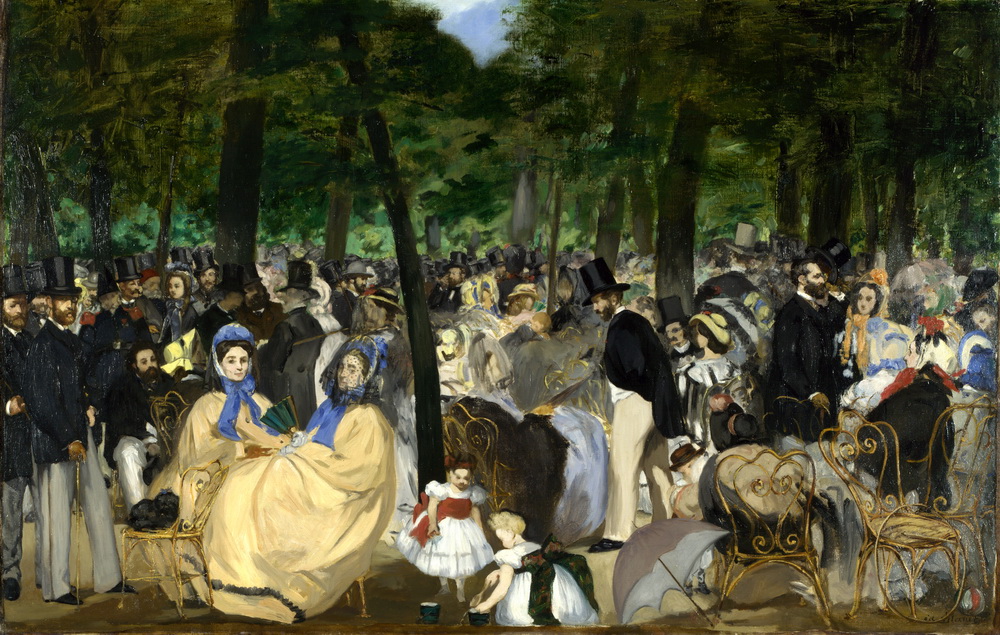
Original Size
(22)Luncheon in the Studio, 1868, Neue Pinakothek, Munich, Germany. Impressionism.

(23)The House at Rueil, 1882, National Gallery of Victoria, Melbourne, Australia. Impressionism.
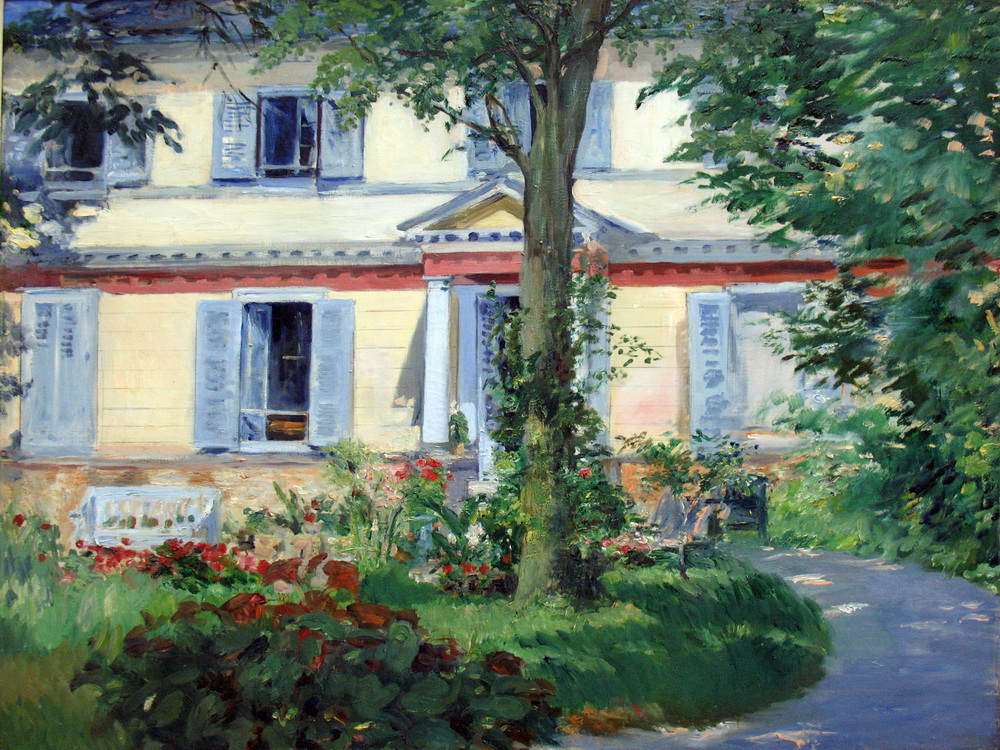
Original Size
(24)The Monet family in their garden at Argenteuil, 1874, Metropolitan Museum of Art, New York City. Impressionism.
By 1874 Manet came under the sway of Monet&s approach to painting quickly, out of doors. In the summer of that year, Manet stayed at his family&s house in Gennevilliers, just across the Seine from Monet in Argenteuil. The Monet family was living in a house that Manet had helped them find the year before. This portrait of the Monet family—Camille Monet and Jean, with Claude Monet gardening at the left—is one of Manet&s most significant essays in this new style. While Manet painted the Monet family, Renoir painted beside him and Monet worked nearby. Monet painted Manet at his easel (present location unknown), while Renoir, like Manet, painted Madame Monet, Jean Monet, and the rooster. In 1924, Monet recounted the circumstances of the day in his garden at Argenteuil: "Manet, enthralled by the color and the light, undertook an outdoor painting of figures under trees. During the sitting, Renoir arrived. . . . He asked me for palette, brush and canvas, and there he was, painting away alongside Manet. The latter was watching him out of the corner of his eye. . . . Then he made a face, passed discreetly near me, and whispered in my ear about Renoir: &He has no talent, that boy! Since you are his friend, tell him to give up painting!&"

(25)Study for "Bar at the Folies-Bergere", 1882, Samuel Courtauld Trust, The Courtauld Gallery, London, UK. Impressionism.

(26)Young woman in the garden, 1880, Private Collection. Impressionism.

(27)Stephane Mallarme, 1876, Musée d&Orsay, Paris, France. Impressionism.

(28)The Races in the Bois de Boulogne, 1872, J. H. Whitney collection. Realism.
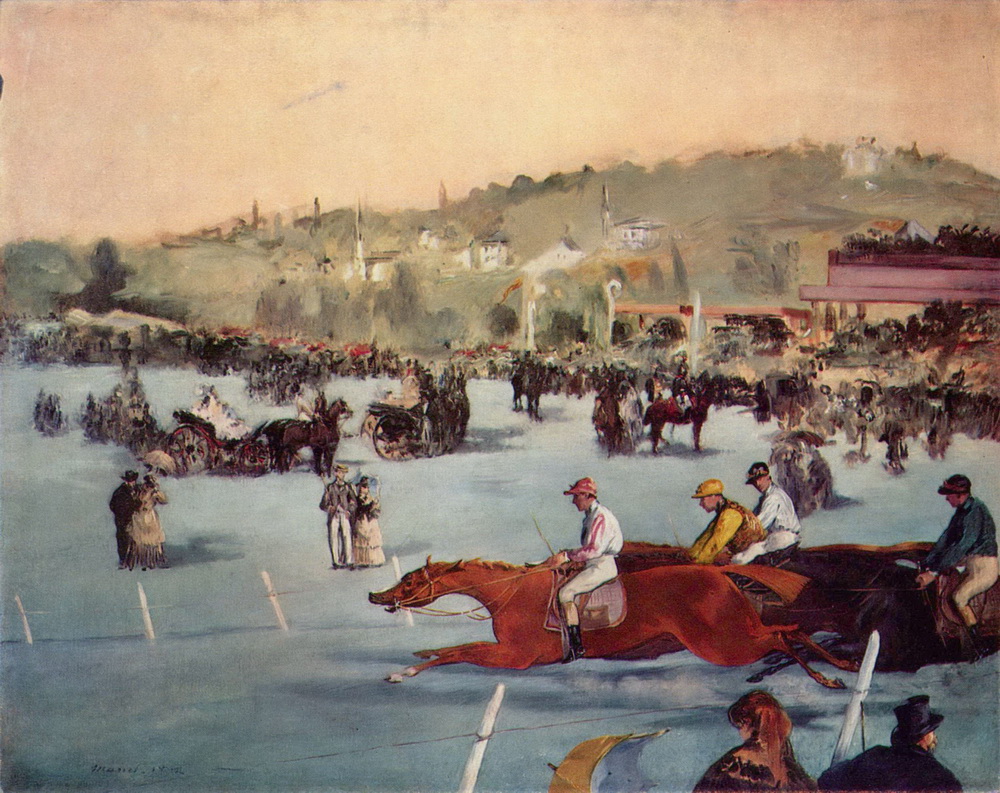
Original Size
(29)The grand canal of Venice (Blue Venice), 1875, Shelburne Museum, Vermont, USA. Impressionism.
Manet visited the Grand Canal Venice in September 1875 with his friend and fellow painter from outside the Impressionist circle James Tissot, who had settled in London after the Franco-Prussian war of 1870-71. Although the watery splendour of Venice has inspired many great artists, Manet found it hard to settle, but in spite of this he managed to paint one of his most dashingly Impressionist art works.
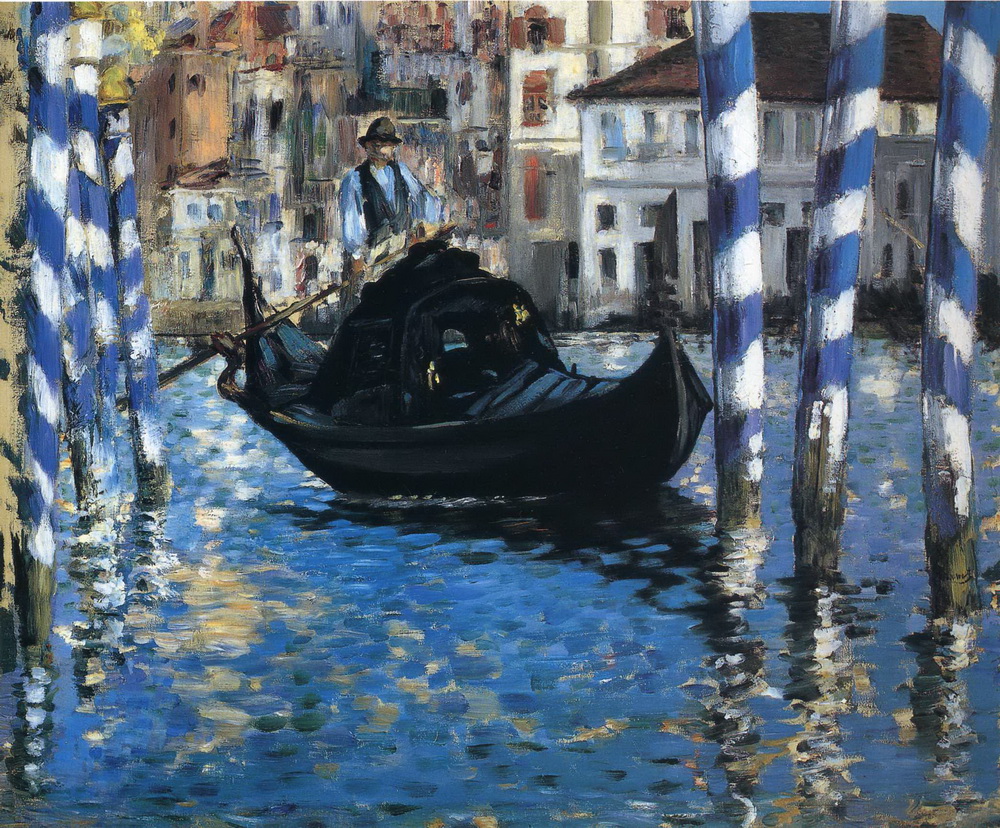
Original Size
(30)Rochefort&s Escape, 1881, Musée d&Orsay, Paris, France. Impressionism.
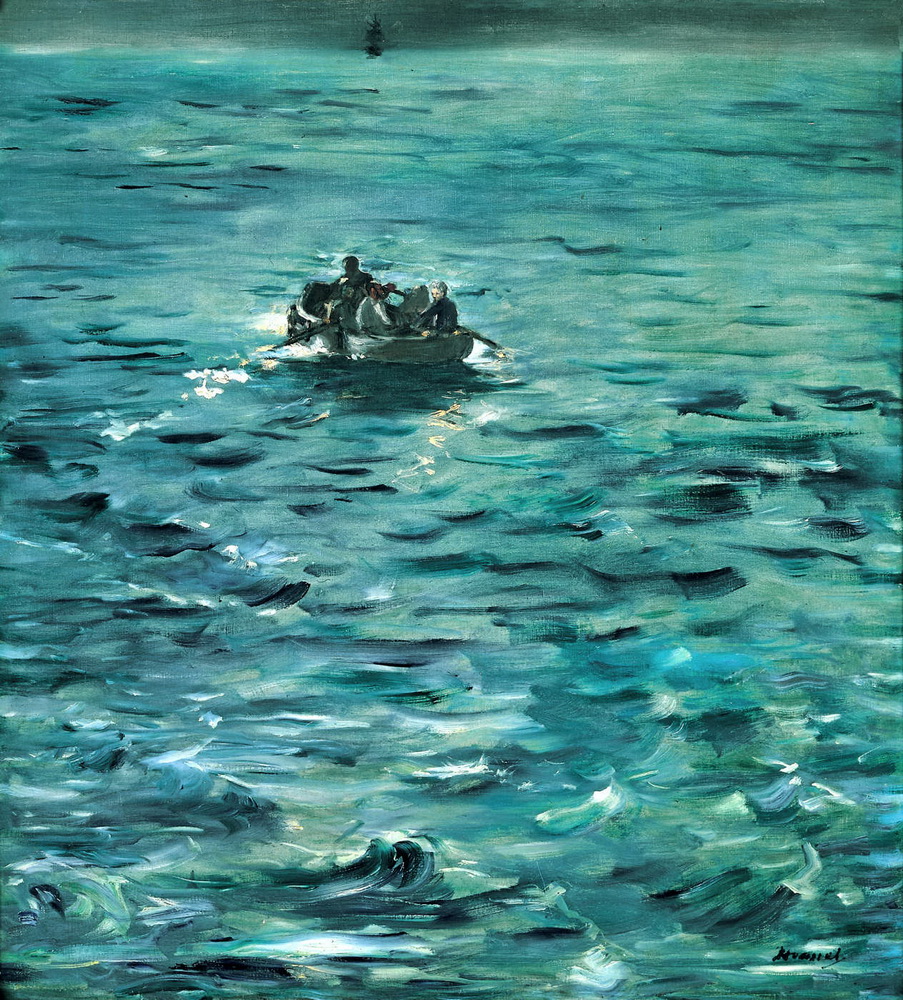
Original Size
(31)Effect of Snow at Petit-Montrouge, 1870, National Museum of Wales, Cardiff, UK. Impressionism.

(32)Woman Before a Mirror, 1877, Solomon R. Guggenheim Museum, New York, USA. Impressionism.

(33)Head of a Dog, 1876, Private Collection. Realism.

(34)Young woman in a round hat, 1877, Impressionism.

(35)Swallows, 1873. Impressionism.
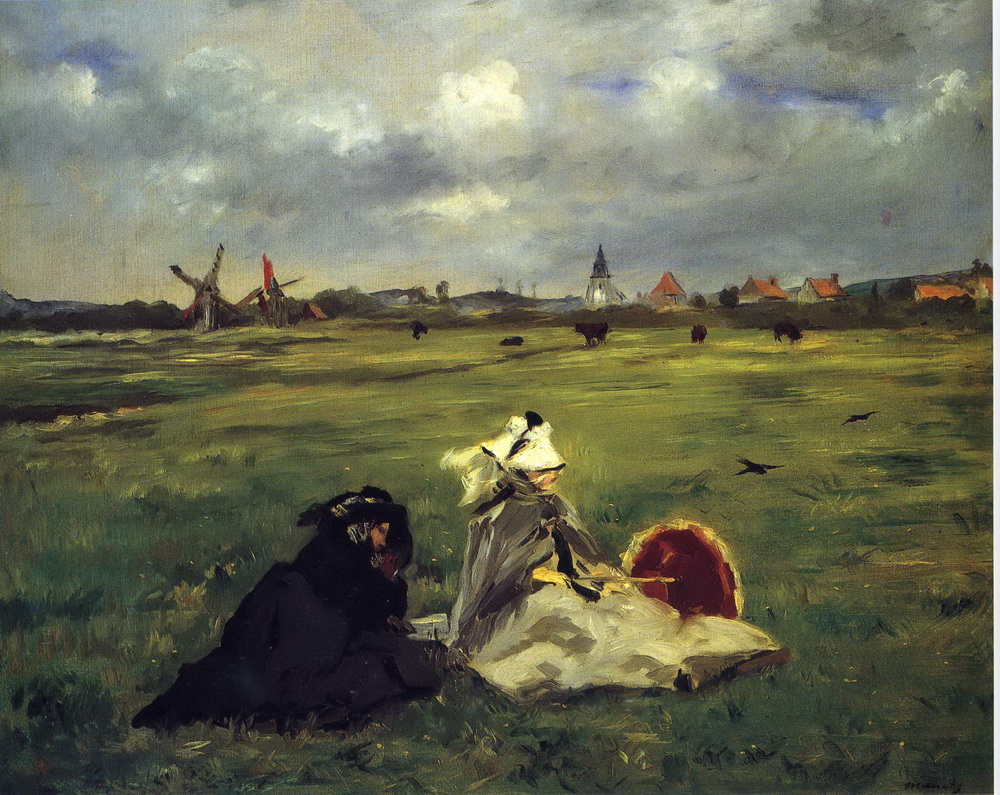
Original Size
(36)Rose and tulip, 1882, Private collection, Zurich, Switzerland. Realism.
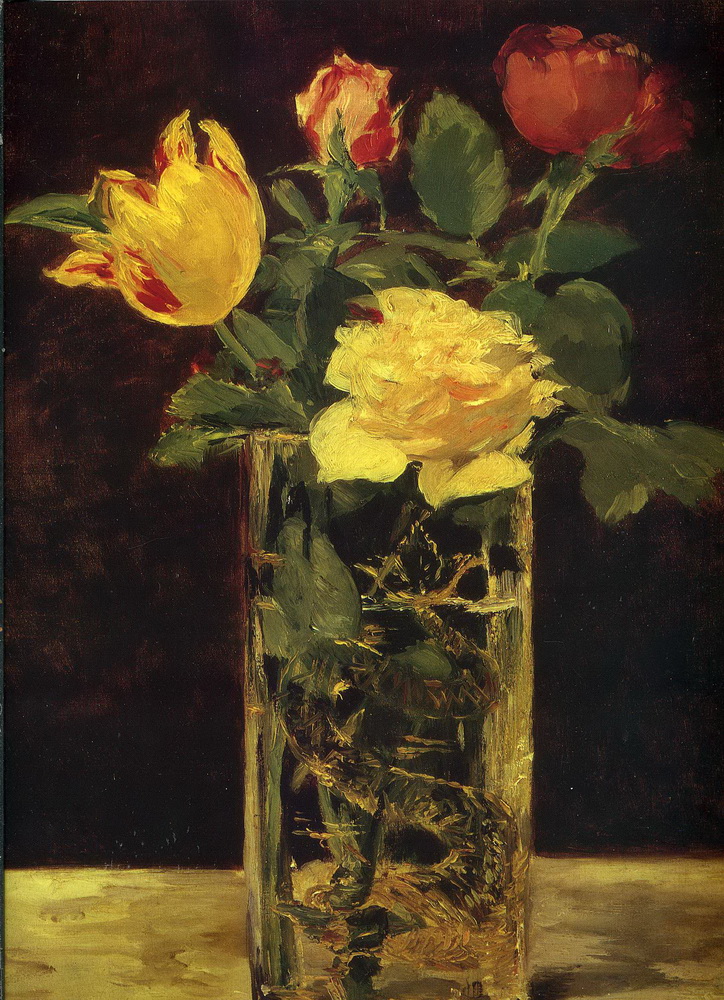
Original Size
(37)The salmon, 1868, Shelburne Museum, Vermont, USA. Realism.
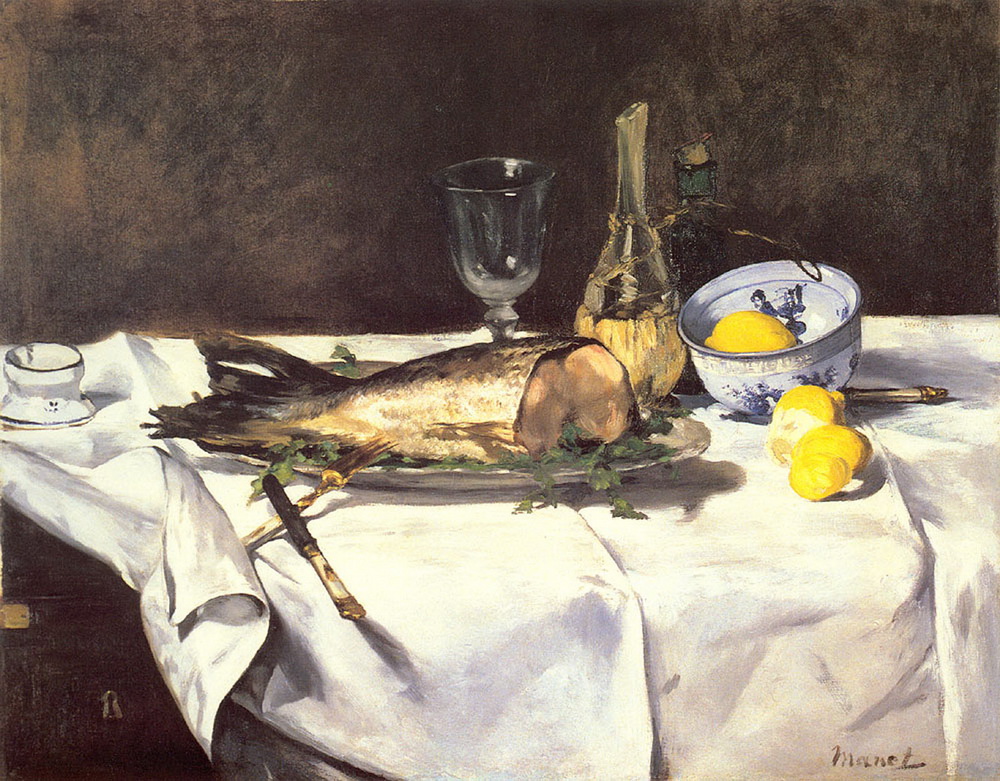
Original Size
(38)Victorine Meurent in the costume of an Espada, 1862, Metropolitan Museum of Art, New York City. Realism.

(39)Still Life: Fruits on a Table, 1864, Musée d&Orsay, Paris, France. Realism.
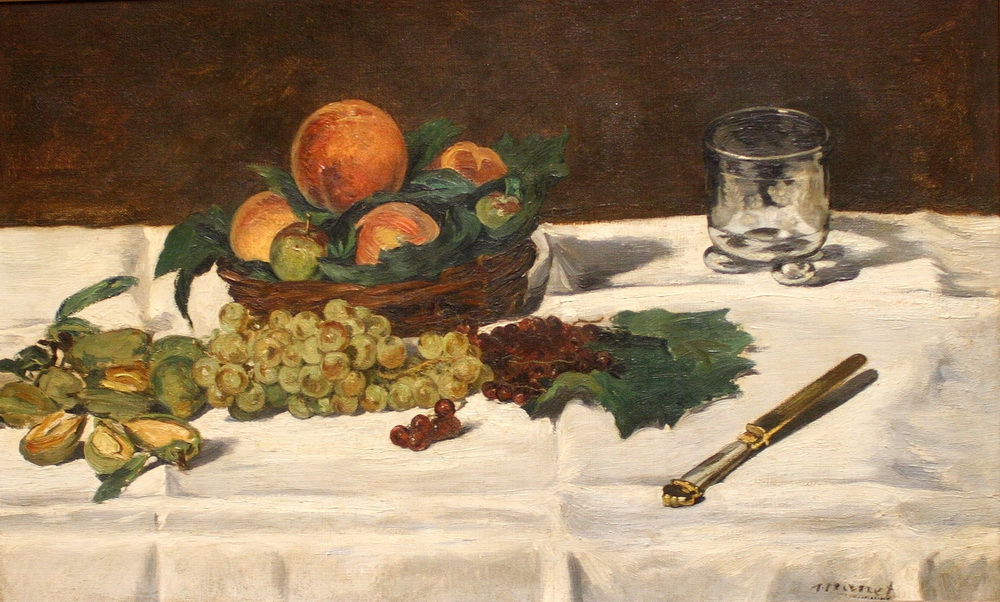
Original Size
(40)A woman pouring water (Study of Suzanne Leenhoff), 1858, Ordrupgaard Collection, Copenhagen, Denmark. Impressionism.
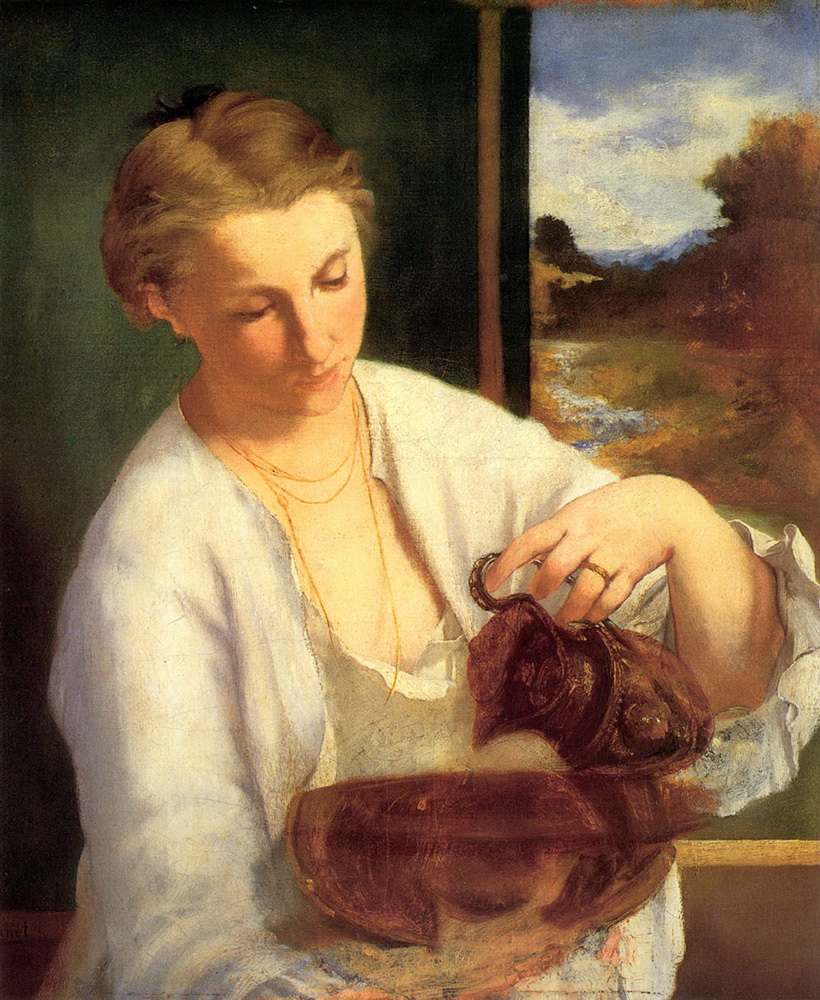
Original Size


